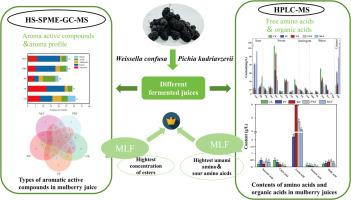Differences in volatility and organoleptic characteristics of mixed and sequential fermentation of mulberry fruit juices by Weissella confusa and Pichia kudriavzevii using metabolomics analysis
IF 7.2
Q1 FOOD SCIENCE & TECHNOLOGY
引用次数: 0
Abstract
Mulberries (Morus alba L. cv. Longsang 1), rich in various nutrients and bioactive compounds. Fermentation can improve the nutritional value of fruit juice processed from mulberries, making it easier to absorb, and can also improve the taste and aroma, thus promoting further development. This study investigates the differences in aroma and sensory attributes between Pichia kudriavzevii and Weissella confusa mixed bacterial fermentation (PWF) and sequentially fermented (MLF) mulberry juices. Headspace solid phase microextraction-gas chromatography-mass spectrometry (HS-SPME-GC-MS) analysis was employed to examine the volatile metabolites in fermentation juice, while high performance liquid chromatography (HPLC)-MS analysis quantified the free amino acid and organic acid content. Additionally, electronic nose and electronic tongue technologies were utilized for sensory evaluation. Results from HS-SPME-GC-MS analysis revealed a notable 61.06% increase in esters in MLF juice, imparting fruity and floral aromas. HPLC-MS analysis indicated a 52.69% increase in sour amino acids in MLF juice, with umami amino acids being 2.23 times higher compared to PWF, resulting in a more pronounced taste profile. Additionally, succinic acid, citric acid, lactic acid, tartaric acid, and malic acid exhibited reductions of 20%, 50%, 12.66%, 75%, and 43.18%, respectively. Electronic tongue and electronic nose analyses demonstrated elevated response values for aromatic components and decreased astringency and bitterness in MLF juice. This research presents a novel fermentation approach to enhance the sensory attributes of fermented mulberry juice.

利用代谢组学分析,对混合发酵和顺序发酵桑椹果汁挥发性和感官特性的差异进行了研究
桑葚(Morus alba L. cv.)龙桑1),富含多种营养成分和生物活性化合物。发酵可以提高桑葚加工果汁的营养价值,使其更容易被吸收,还可以改善口感和香气,从而促进进一步的发展。研究了混合细菌发酵(PWF)和顺序发酵(MLF)桑椹汁在香气和感官特性上的差异。采用顶空固相微萃取-气相色谱-质谱联用(HS-SPME-GC-MS)分析发酵液中挥发性代谢物,高效液相色谱-质谱联用(HPLC -MS)分析游离氨基酸和有机酸含量。此外,利用电子鼻和电子舌技术进行感官评估。HS-SPME-GC-MS分析结果显示,MLF果汁中酯类含量显著增加61.06%,具有水果和花香的香味。HPLC-MS分析表明,与PWF相比,MLF果汁中酸性氨基酸含量增加了52.69%,鲜味氨基酸含量增加了2.23倍,口感更加明显。此外,琥珀酸、柠檬酸、乳酸、酒石酸和苹果酸分别减少20%、50%、12.66%、75%和43.18%。电子舌和电子鼻分析表明,在MLF果汁中,芳香成分的响应值提高,涩味和苦味降低。本研究提出了一种新的发酵方法来提高发酵桑椹汁的感官属性。
本文章由计算机程序翻译,如有差异,请以英文原文为准。
求助全文
约1分钟内获得全文
求助全文

 求助内容:
求助内容: 应助结果提醒方式:
应助结果提醒方式:


